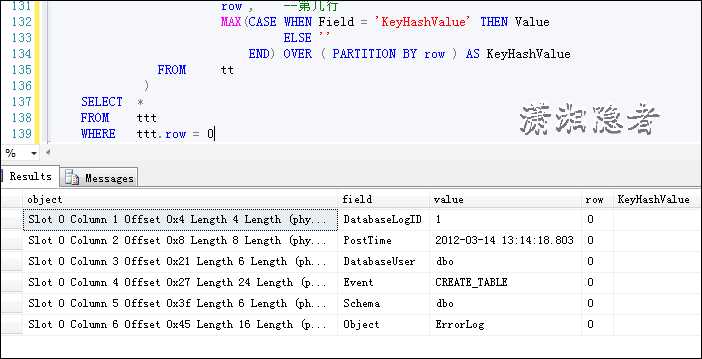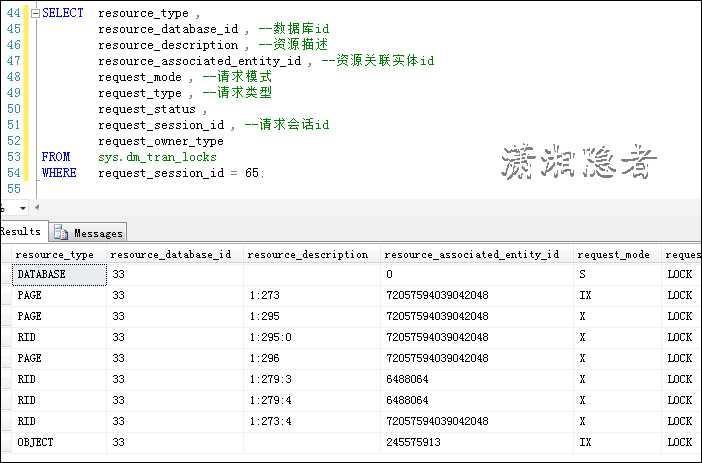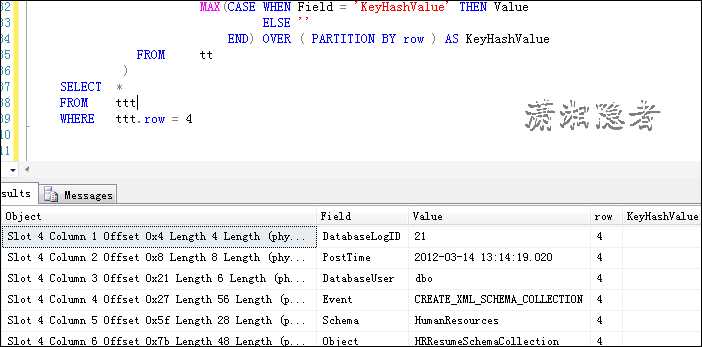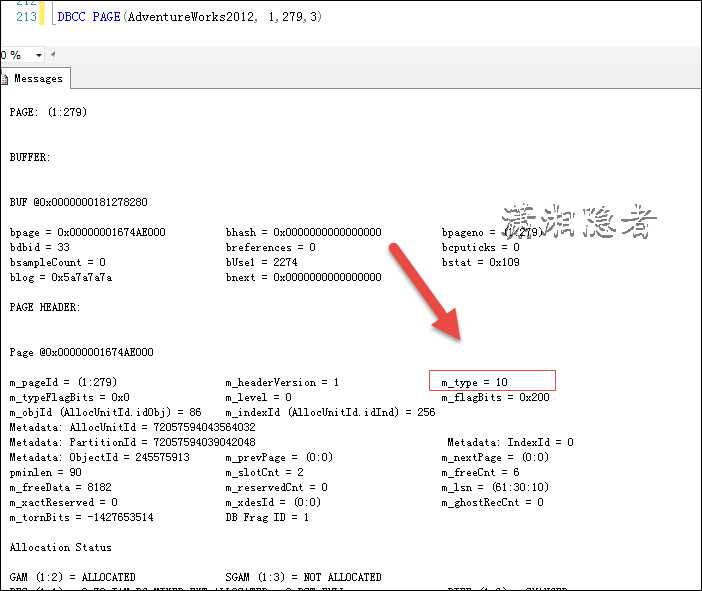SQL Server中如何定位Row Lock锁定哪一行数据
Posted lonelyxmas
tags:
篇首语:本文由小常识网(cha138.com)小编为大家整理,主要介绍了SQL Server中如何定位Row Lock锁定哪一行数据相关的知识,希望对你有一定的参考价值。
原文:SQL Server中如何定位Row Lock锁定哪一行数据在SQL Server中有时候会使用提示(Hint)强制SQL使用行锁(Row Lock),前两天有个同事咨询了一个问题,如何定位Row Lock具体锁定了哪一行。其实这个问题只适合研究一下,实际意义并不大,因为找到、定位被锁定的行的代价开销较大,而意义却不怎么大,而且使用场景也很少。那么下面我们来探讨、研究一下这个问题吧:
在会话窗口(会话ID=65)下执行下面SQL语句,模拟SQL Server使用行锁锁定某一行记录:
USE AdventureWorks2012;GOSELECT @@SPID;BEGIN TRAN;
UPDATE [dbo].[DatabaseLog] WITH ( ROWLOCK )
SET TSQL = N‘dddd‘
WHERE DatabaseLogID = 1;--ROLLBACK;
在另外一个会话窗口使用下面SQL查询,我们能看到相关锁的一些信息,如下所示,但是这些信息还不够详细,我们还需要更详细的信息:
SELECT Db_name(RSC_DBID) AS ‘DATABASE_NAME‘,
CASE RSC_TYPE WHEN 1 THEN ‘null‘
WHEN 2 THEN ‘DATABASE‘
WHEN 3 THEN ‘FILE‘
WHEN 4 THEN ‘INDEX‘
WHEN 5 THEN ‘TABLE‘
WHEN 6 THEN ‘PAGE‘
WHEN 7 THEN ‘KEY‘
WHEN 8 THEN ‘EXTEND‘
WHEN 9 THEN ‘RID ( ROW ID)‘
WHEN 10 THEN ‘APPLICATION‘
END AS ‘REQUEST_TYPE‘,
CASE REQ_OWNERTYPE WHEN 1 THEN ‘TRANSACTION‘
WHEN 2 THEN ‘CURSOR‘
WHEN 3 THEN ‘SESSION‘
WHEN 4 THEN ‘ExSESSION‘
END AS ‘REQUEST_OWNERTYPE‘,
Object_name(RSC_OBJID, RSC_DBID) AS ‘OBJECT_NAME‘,
PROCESS.HOSTNAME,
PROCESS.NT_DOMAIN,
PROCESS.NT_USERNAME,
PROCESS.PROGRAM_NAME,
SQLTEXT.TEXT
FROM sys.syslockinfo LOCK JOIN sys.sysprocesses PROCESS ON LOCK.REQ_SPID = PROCESS.SPID CROSS apply sys.DM_EXEC_SQL_TEXT(PROCESS.SQL_HANDLE) SQLTEXT WHERE PROCESS.SPID = 65
查询sys.dm_tran_locks我们可以得到更详细的信息,例如,从resource_description中我们可以得到file_id=1, 页面编号为273,这个页面的第一条记录(0)
SELECT resource_type ,
resource_database_id , --数据库id
resource_description , --资源描述
resource_associated_entity_id , --资源关联实体id
request_mode , --请求模式
request_type , --请求类型
request_status ,
request_session_id , --请求会话id
request_owner_type
FROM sys.dm_tran_locks
WHERE request_session_id = 65;
准备下面脚本,为了后续我们定位到行锁锁定哪一行记录。准备好后面脚本后,我们就可以开始测试了。注意,需要开启跟踪DBCC TRACEON(3604)。否则DBCC PAGE没有任何输出信息
IF EXISTS (SELECT * FROM sys.objects WHERE type=‘U‘ AND name=‘DBCC_PAGE_RESULT‘)
DROP TABLE DBCC_PAGE_RESULT;
GOCREATE TABLE DBCC_PAGE_RESULT
(
[ParentObject] NVARCHAR(200),
[Object] NVARCHAR(2000),[Field] NVARCHAR(4000),
[Value] NVARCHAR(MAX)
)
GOCREATE PROCEDURE PRC_DBCC_PAGE
(
@dbid INT, @filenum INT, @pagenum INT)
ASDBCC PAGE(@dbid, @filenum, @pagenum, 3) WITH TABLERESULTS;
GODBCC TRACEON(3604);WITH t AS ( SELECT Object ,
Field ,
Value ,CASE WHEN CHARINDEX(‘Column‘, Object) > 0
THEN CHARINDEX(‘Column‘, Object)
ELSE CHARINDEX(‘Offset‘, Object)
END AS substring_len
FROM dbo.DBCC_PAGE_RESULT dpWHERE Object LIKE ‘Slot%Column%‘
OR Field = ‘KeyHashValue‘
),
tt
AS ( SELECT Object ,
Field ,
Value ,CAST(SUBSTRING(Object, LEN(‘Slot‘) + 1,
substring_len - LEN(‘Slot‘) - 1) AS INT) AS row
FROM t),
ttt
AS ( SELECT Object ,
Field ,
Value , row , --第几行 MAX(CASE WHEN Field = ‘KeyHashValue‘ THEN Value
ELSE ‘‘
END) OVER ( PARTITION BY row ) AS KeyHashValue
FROM tt)
SELECT * FROM tttWHERE ttt.row = 0
如下截图所示,就可以找到行锁(Row Lock)锁定了row=0这行记录(注意,这里的行记录是从0开始的,而不是1),也就是DatabaseLogID=1的记录。如果1:273:2, 那么查询条件中row=2 这个表示这个页面的第几行记录。
但是,有时候你锁定了一行,查询sys.dm_tran_locks时,你会发现resource_type为RID类型的记录有好几条,如下所示:
USE AdventureWorks2012;GOSELECT @@SPID;BEGIN TRAN;
UPDATE [dbo].[DatabaseLog] WITH ( ROWLOCK )
SET TSQL = N‘dddd‘
WHERE DatabaseLogID = 21;--ROLLBACK;
其实真正是数据页的只有resource_description=1:273:4 这行记录, 也就是说这行记录位于Page Number=273下的第5条记录
其它一些页面,例如 1,295; 1,279等都不是数据页,如下截图所示:m_type的值表示这个是数据页、索引页、IAM页等等。具体参考
m_type
· This is the page type. The values you’re likely to see are:
o 1 – data page. This holds data records in a heap or clustered index leaf-level.
o 2 – index page. This holds index records in the upper levels of a clustered index and all levels of non-clustered indexes.
o 3 – text mix page. A text page that holds small chunks of LOB values plus internal parts of text tree. These can be shared between LOB values in the same partition of an index or heap.
o 4 – text tree page. A text page that holds large chunks of LOB values from a single column value.
o 7 – sort page. A page that stores intermediate results during a sort operation.
o 8 – GAM page. Holds global allocation information about extents in a GAM interval (every data file is split into 4GB chunks – the number of extents that can be represented in a bitmap on a single database page). Basically whether an extent is allocated or not. GAM = Global Allocation Map. The first one is page 2 in each file. More on these in this post.
o 9 – SGAM page. Holds global allocation information about extents in a GAM interval. Basically whether an extent is available for allocating mixed-pages. SGAM = Shared GAM. the first one is page 3 in each file. More on these in this post.
o 10 – IAM page. Holds allocation information about which extents within a GAM interval are allocated to an allocation unit (portion of a table or index). IAM = Index Allocation Map. More on these in this post.
o 11 – PFS page. Holds allocation and free space information about pages within a PFS interval (every data file is also split into approx 64MB chunks – the number of pages that can be represented in a byte-map on a single database page. PFS = Page Free Space. The first one is page 1 in each file. More on these in this post.
o 13 – boot page. Holds information about the database. There’s only one of these in the database. It’s page 9 in file 1.
o 15 – file header page. Holds information about the file. There’s one per file and it’s page 0 in the file.
o 16 – diff map page. Holds information about which extents in a GAM interval have changed since the last full or differential backup. The first one is page 6 in each file.
o 17 – ML map page. Holds information about which extents in a GAM interval have changed while in bulk-logged mode since the last backup. This is what allows you to switch to bulk-logged mode for bulk-loads and index rebuilds without worrying about breaking a backup chain. The first one is page 7 in each file.
o 18 – a page that’s be deallocated by DBCC CHECKDB during a repair operation.
o 19 – the temporary page that ALTER INDEX … REORGANIZE (or DBCC INDEXDEFRAG) uses when working on an index.
o 20 – a page pre-allocated as part of a bulk load operation, which will eventually be formatted as a ‘real’ page.
参考资料:
http://blog.csdn.net/sqlserverdiscovery/article/details/13291629
https://www.sqlskills.com/blogs/paul/inside-the-storage-engine-anatomy-of-a-page/
以上是关于SQL Server中如何定位Row Lock锁定哪一行数据的主要内容,如果未能解决你的问题,请参考以下文章
SQL Server中如何定位Row Lock锁定哪一行数据






